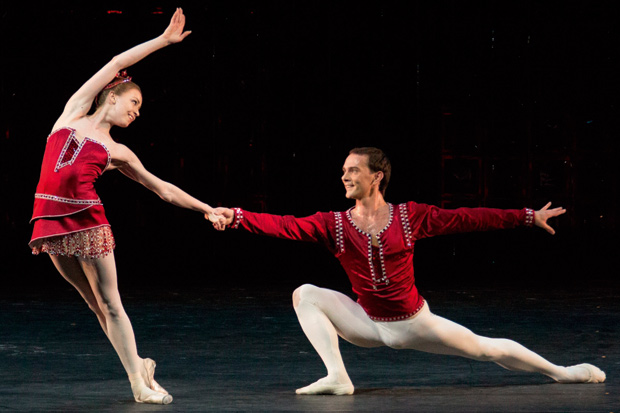Jewels is everything a George Balanchine admirer could ask for. The sumptuous triptych, set to scores by Fauré, Stravinsky and Tchaikovsky, is a compendium of what Balanchine’s style is about; each part — Emeralds, Rubies and Diamonds — provides unique insights into the subtleties, signature features and inventiveness that inform the art of the Russian master who fathered American ballet.
Yet on these shores Jewels is seldom a sell-out production. Unless, of course, it is danced by the Bolshoi Ballet. Comparisons are odious, but seasoned dance-goers could not help noticing that, on Monday, the Royal Opera House was packed to the brim. The lure of the exotic, the hype of the advertising campaign, and the fact that the tourist season is at its peak are factors that cannot be discounted; but there is also word of mouth and, more particularly, the word of mouth of discerning ballet-goers.
I could not agree more with them. As soon as the curtain went up on each section, people gasped with excitement, as they were confronted with a masterclass in stage presence, something that the majority of western dance teachers, repetiteurs and coaches seem to have forgotten or simply ignore. There is also aesthetic consistency: each initial grouping abides strictly by the rules of what ballet is and should be, no matter how un-PC these are in the eyes of some (and, let’s face it, ballet, like sport, is un-PC by default).
There is not, in other words, that mismatched array of forms and shapes one has to put up with in other and more familiar corps de ballet. Nor is there any slacking in theatrical tension. Everyone on stage, down to the last chorus girl, comes across as vibrantly involved, as if he or she were the true star of the moment. It’s no wonder that the effect is so blindingly amazing each time. Indeed, there is also consistency of training and technical bravura, evident not just in the superb principals that led each section but also in every company member.
Refined technique, however, is not all that is needed for Jewels. Stylistically, the Bolshoi performance I saw was not ideal. It is difficult to pinpoint from where these inconsistencies stemmed, for there is more to it than just the diversity of training and choreographic styles. Excessively slow tempi were often an inexplicable let-down, given that within the past few weeks the Bolshoi artists have demonstrated that they are fairly well acquainted with brisk footwork and dancing, unlike some of their western counterparts. It is more than possible that they, too, in tackling Balanchine, have succumbed to the trend of exasperatingly sustained legatos, which, together with hyper-extended legs, has now spread like a gangrenous illness across the whole ballet world. Care should also have been taken with the hand movements, particularly in Emeralds, which, romantic-looking as it may be, is not a Romantic ballet, and Rubies, where the jazzy gestures did not look right at all. Only in Diamonds did technique and style come successfully together, thanks also to the incandescent presence of Olga Smirnova, a ballerina Balanchine himself would have adored, for sure.
All good things come to an end, and the Bolshoi season in London will soon be over. It finishes this week after a final firework, namely three performances of the revived The Flames of Paris. Still, vivid memories of this 50th-anniversary season will long remain, together with the reassurance that somewhere in the world ballet is alive.






Comments